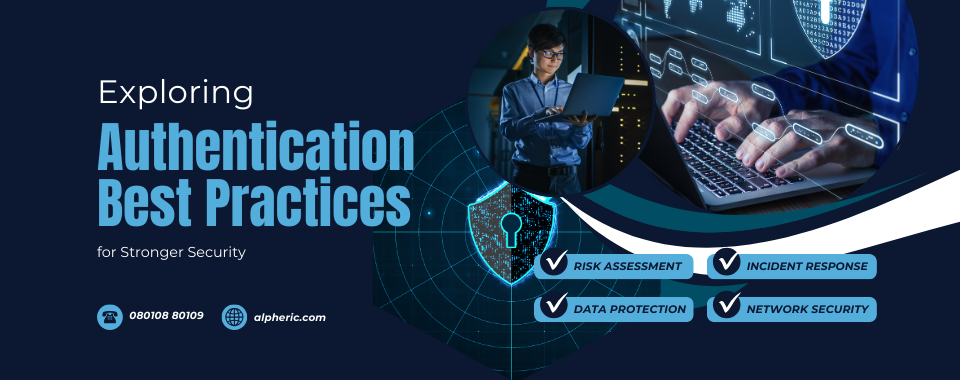
As cybercriminals become increasingly sophisticated, traditional authentication methods like passwords are no longer enough to protect businesses from potential breaches. In this blog, we will explore authentication best practices that can help strengthen your security and safeguard sensitive information.
What is Authentication?
Authentication is the process of verifying the identity of a user or system trying to access a network, device, or data. It’s the first line of defense in cybersecurity, ensuring that only authorized individuals can gain access to sensitive information or resources. But not all authentication methods are created equal, and as threats evolve, businesses must adopt stronger, multi-layered security practices.
Why Strong Authentication is Crucial
With data breaches becoming increasingly common, strong authentication measures are essential for reducing the risk of unauthorized access. A weak authentication process can expose organizations to several risks:
Data Breaches: Compromised credentials can lead to unauthorized access to confidential data, causing reputational and financial damage.
Account Takeovers: Cybercriminals can use stolen credentials to take over accounts and carry out malicious activities.
Compliance Violations: Many industries are subject to regulations that require strong authentication measures. Failing to meet these standards can result in penalties.
Best Practices for Strong Authentication
1. Implement Multi-Factor Authentication (MFA)
What It Is: MFA adds an extra layer of security by requiring users to provide two or more verification factors to access an account or system.
Why It Matters: Relying solely on passwords is risky, as passwords can be stolen or guessed. MFA enhances security by combining something the user knows (a password) with something they have (a mobile device for codes) or something they are (biometrics).
How to Implement: Enable MFA for all accounts, particularly those with access to sensitive data or systems. Encourage the use of apps like Google Authenticator or hardware tokens for additional security.
2. Use Strong, Unique Passwords
What It Is: A strong password is one that is long, complex, and unique for each account. It typically contains a mix of uppercase and lowercase letters, numbers, and special characters.
Why It Matters: Weak or reused passwords are easy targets for cybercriminals using brute-force attacks or credential-stuffing techniques. Unique, complex passwords make it harder for attackers to crack them.
How to Implement: Encourage employees to create long passwords (at least 12 characters) and avoid using the same password for multiple accounts. Consider using password managers to help generate and store complex passwords securely.
3. Leverage Biometrics
What It Is: Biometric authentication uses physical characteristics like fingerprints, facial recognition, or iris scans to verify a user’s identity.
Why It Matters: Unlike passwords, which can be stolen, biometric data is unique to each individual, making it difficult for cybercriminals to replicate. This adds an extra layer of security that is harder to bypass.
How to Implement: Integrate biometric authentication into your organization’s security protocols, especially for accessing highly sensitive systems or information. Many devices now support biometric features like fingerprint scanners or facial recognition, making implementation easier.
4. Use Adaptive Authentication
What It Is: It is a method that evaluates various risk factors—such as the user’s location, device, or behavior—before granting access.
Why It Matters: Adaptive authentication tailors the security level based on the perceived risk. For example, if a user tries to log in from an unusual location or device, the system may require additional verification.
How to Implement: Deploy adaptive authentication tools that monitor login behavior and adjust security measures accordingly. This allows for a balance between user convenience and security without compromising on either.
5. Implement Single Sign-On (SSO) with Secure Standards
What It Is: Single Sign-On (SSO) allows users to authenticate once and gain access to multiple applications or systems without needing to log in again.
Why It Matters: SSO improves user experience and reduces the number of passwords users need to remember, but it must be implemented securely. Integrating SSO with protocols like SAML (Security Assertion Markup Language) ensures encrypted communication between authentication servers and applications.
How to Implement: Use SSO solutions that comply with industry security standards. Ensure that SSO is paired with MFA to strengthen the authentication process further.
6. Implement Secure Password Policies
What It Is: Password policies outline the guidelines for creating, using, and managing passwords within an organization.
Why It Matters: Without a formal policy, employees may use weak or easily guessable passwords, increasing the risk of compromise. Strong password policies enforce good habits and help keep accounts secure.
How to Implement: Define password expiration periods, complexity requirements, and reuse restrictions. Set up systems to enforce these policies and provide employees with guidance on creating secure passwords.
7. Regularly Review and Revoke Access
What It Is: Regular access reviews ensure that users only have the permissions necessary for their role. Revoking access to former employees or unnecessary accounts is essential for minimizing security risks.
Why It Matters: Over time, employees may accumulate access to systems they no longer need. Keeping these permissions active increases the risk of unauthorized access or insider threats.
How to Implement: Conduct routine access reviews, especially after role changes or terminations. Use tools that automatically deactivate accounts after a period of inactivity.
When to Implement Stronger Authentication Practices
Authentication practices should be continuously improved and adapted as the threat evolves. However, there are key times when strengthening your authentication protocols is especially crucial:
During Onboarding: Implement secure authentication methods for all new employees and contractors from day one.
After a Security Incident: If your organization has experienced a data breach or unauthorized access, review your current authentication measures and enhance them as needed.
Before System Upgrades: When deploying new systems or applications, ensure they support modern, secure methods like MFA and biometrics.
Authentication as the Foundation of Security
It is the cornerstone of any organization’s security strategy. By adopting best practices such as MFA, strong password policies, and biometric authentication, businesses can significantly reduce the risk of unauthorized access and cyberattacks. As the digital landscape evolves, so too must your methods. Stay ahead of cybercriminals by continuously improving and strengthening your protocols—after all, your organization’s security depends on it.
Follow for more insights








